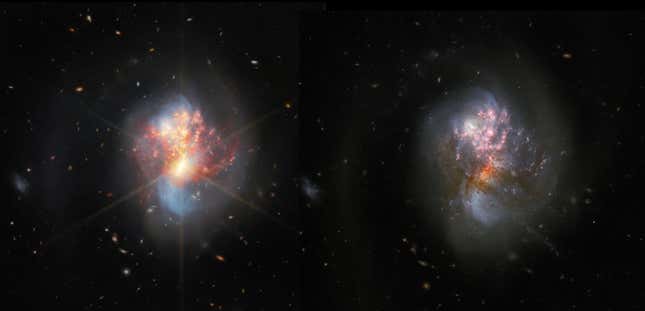
This summer, Webb Space Telescope imaged a pair of merging galaxies known as IC 1623 A and B (collectively, just IC 1623). Now, the veteran Hubble Space Telescope has captured a new shot of the same pair, after first imaging them back in 2008. The differences in the two views showcase the varying strengths of these telescopes, as one sees the universe primarily in visible and ultraviolet light and the other sees in infrared.
The galaxy merger was first discovered in 1897, and the Hubble and Webb telescopes offer remarkable views of the cosmic dance. The galaxies are about 270 million light-years from Earth, in the constellation Cetus. Stars in the galaxies are being formed about 20 times faster than stars in the Milky Way.
Webb mainly sees infrared and near-infrared wavelengths, which are redder than the reddest visible light. That allows the telescope to see some of the most ancient (redshifted) light in the universe, going back to just several hundred million years after the Big Bang.

The $10 billion Webb telescope launched from French Guiana in December 2021; the precision of the telescope’s launch means that the mission lifetime could be as long as 20 years, a big jump from the original five-year mission plan.
Webb is the latest and greatest, but its predecessor is still kicking. Hubble launched in 1990 and since then has been one of humankind’s most useful tools for studying the cosmos. The aging telescope has stuttered in recent years, but it continues to deliver images primarily at the visible and ultraviolet wavelengths, which Webb does not. For that reason, the folks at NASA consider Webb to be Hubble’s successor rather than its replacement.

The two telescopes’ images of the galaxy pair showcase their respective capabilities. The system is bright in the infrared, making it a sensible target for Webb. The intense star formation in the merger produces infrared light, but a thick band of dust has blocked a lot of the galaxy’s detail from view for years.
Webb is able to pierce through clouds of dust, to see more than what Hubble can. Its image of the galaxy merger—a vibrant starburst of red and blue—cuts right through the obfuscating dust present in the Hubble image. The background galaxies are also much clearer in Webb’s rendition.
As Webb’s exploration of the cosmos continues, it almost certainly will capture more views first seen by Hubble, like its recent shot of the Pillars of Creation. Wherever Webb looks next, keep in mind that Hubble helped pave the way.